Chapter 10
1/77
There's no tags or description
Looks like no tags are added yet.
Name | Mastery | Learn | Test | Matching | Spaced |
|---|
No study sessions yet.
78 Terms
What are the 3 types of muscle tissue?
Cardiac Muscle → Found in the heart.
Smooth Muscle → Found in walls of hollow organs (e.g., stomach, small & large intestines).
Skeletal Muscle → Attached to bones; makes up ~50% of body mass.
What are the properties of muscle tissue?
Contractility, Excitability, Extensibility and Elasticity
What is contractility?
The property that muscle can shorten forcefully with actin and myosin
What is excitability?
the property of muscle cells to respond to nerve signals (or other stimuli) by generating electrical impulses along the sarcolemma, which then trigger contraction.
What is extensibility?
The ability of a muscle to be stretched beyond its resting length. Stretch occurs when the muscle is moved in the opposite direction of its normal contraction.
Example: An arm abductor is stretched when the arm moves toward the body (adduction).
What is elasticity?
The property for muscle to recoil back to its resting length after being strength
What is myo/mys and sarco?
myo/mys = muscle and sarco = flesh
What is sacolemma?
plasma membrane of muscle cells ("flesh sheath").
What is sarcoplasm?
cytoplasm of muscle cells
What are myofilaments?
filaments with actin & myosin (contractile proteins).
How do muscle produce movement?
Skeletal Muscle → moves body by moving bones.
Smooth Muscle → squeezes fluids & substances through hollow organs.
What is a sphincter and how does it function?
Sphincter: a circular muscle that acts as a valve to open or close a passageway.
Function:
Relax → allows substances to pass through.
Contract → blocks passage of substances.
Examples: digestive tract, urinary tract, mouth, eyes, pupil of eye.
How do muscles maintain posture and stabilize joints?
Muscles enable the body to remain sitting or standing.
Muscle tone: constant, low-level contraction that helps stabilize synovial joints.
How do muscles generate heat?
Muscle contractions produce heat, helping maintain normal body temperature (37°C / 98.6°F).
During exercise, extra heat is produced → body cools by sweating.
What is the location and control type of skeletal muscle tissue?
Location: Skeletal muscles (attached to bones)
Control: Voluntary (conscious control by nervous system)
What are the characteristics of skeletal muscle cells?
Striated (striped appearance)
Long, cylindrical cells called muscle fibers
Formed by fusion of embryonic cells called myotubes
Multinucleate, with nuclei located peripherally under the sarcolemma
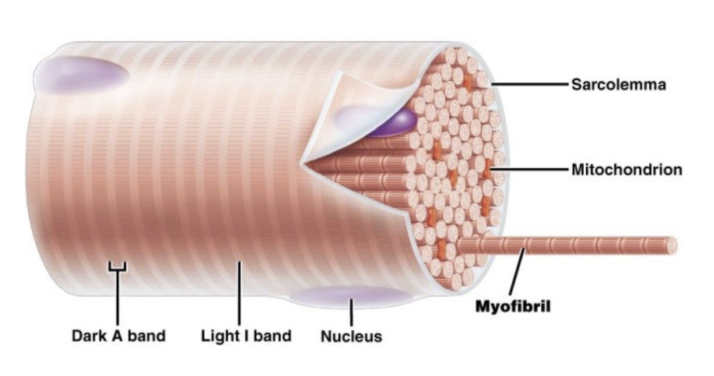
Where is cardiac muscle tissue found and how is it controlled?
Location: Only in the heart wall
Control: Involuntary (regulated by nervous system)
Can contract without nerve stimulation
What are the characteristics of cardiac muscle cells?
Striated but branched
Not called fibers
Where is smooth muscle tissue found and how is it controlled?
Location: Walls of hollow organs (stomach, bladder, blood vessels, respiratory tubes)
Control: Involuntary (nervous system)
What are the characteristics of smooth muscle cells?
Not striated
Elongated cells called muscle fibers
What is visceral muscle?
Combination of cardiac + smooth muscle
Occurs in visceral organs and is involuntary
What is a muscle considered in terms of organ structure?
Muscle is an organ
Made up mostly of muscle tissue
Also contains connective tissue, blood vessels, and nerves
What is the role of connective tissue in skeletal muscles?
Provides support and structure
Binds muscle fibers into fascicles and whole muscle
Transmits contractile force to tendons
Provides elasticity and carries blood vessels & nerves
Name the three connective tissue layers in skeletal muscles and what they surround?
Epimysium: surrounds the entire muscle
Perimysium: surrounds fascicles (groups of muscle fibers)
Endomysium: surrounds individual muscle fibers
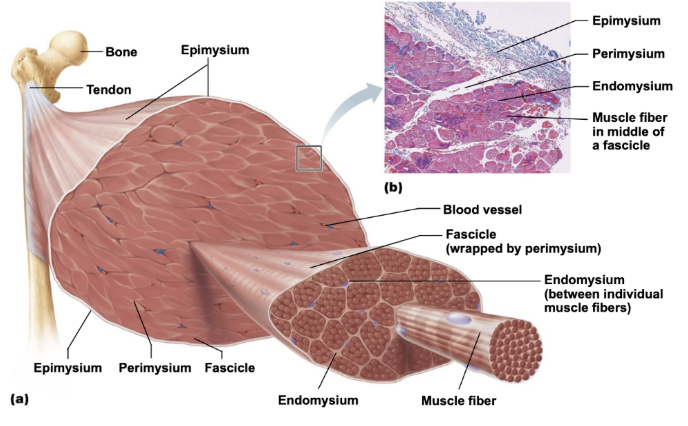
How are skeletal muscles supplied with nerves and blood vessels?
Each muscle has 1 nerve, 1 artery, and 1+ veins
Enter near the muscle’s middle and branch repeatedly
Smallest branches serve individual muscle fibers
How do capillaries in the endomysium change during muscle contraction and extension?
Wavy when muscle contracts
Straight when muscle stretches
What is the general concept of muscle attachments?
Most muscles run bone to bone. One bone moves (insertion), the other stays fixed (origin). Contraction pulls the insertion toward the origin. Origin & insertion can switch depending on movement (e.g., chin-ups).
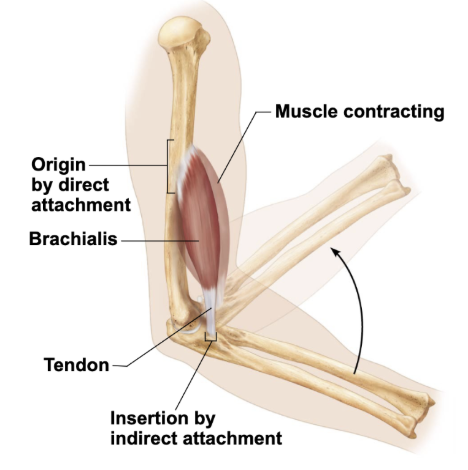
What are the two main types of muscle attachments?
Fleshy (direct): short CT fibers attach fascicles directly to bone.
Indirect (common): connective tissue extends beyond the muscle as a tendon (cordlike) or aponeurosis (flat sheet).
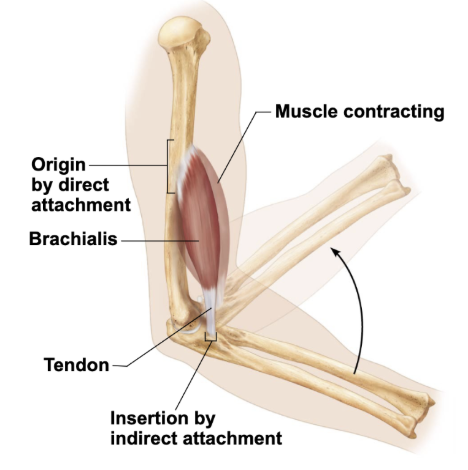
Where can tendons or aponeuroses attach besides bone?
Skin, cartilage, fascia, or raphe (fibrous seam).
What are multi-joint muscles?
Muscles that span 2 or more joints. Contraction moves multiple joints (e.g., a muscle crossing both the elbow & wrist).
What are myofibrils?
Long rods in muscle fiber cytoplasm that make up ~80% of it. Specialized contractile organelles composed of repeating segments called sarcomeres.
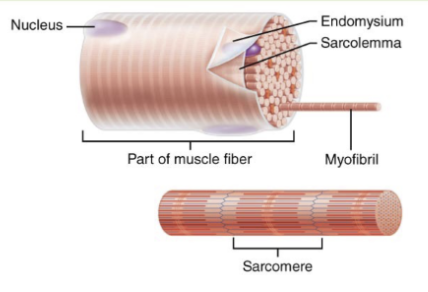
What is a sarcomere?
The functional unit of skeletal muscle; shortens during contraction. Z discs mark its boundaries. Striations in muscle fibers come from the arrangement of sarcomeres.
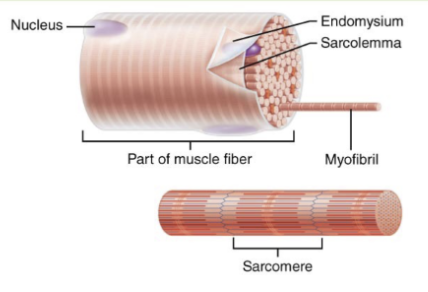
What are thin filaments and what proteins do they contain?
Extend from Z disc toward sarcomere center.
Contain:
Actin: primary contractile protein
Tropomyosin: spirals around actin
Troponin: binds actin, tropomyosin, and calcium; regulates actin-myosin interaction
What are thick filaments and what proteins do they contain?
Located in sarcomere center, overlapping thin filaments. Composed mainly of myosin molecules. Myosin heads bind actin and perform the cross-bridge cycle. Contain ATPase enzymes to release energy for contraction.
What is the A band in a sarcomere?
Dark band; full length of thick filament, includes overlap with thin filaments.
A = anisotropic (refracts polarized light differently).
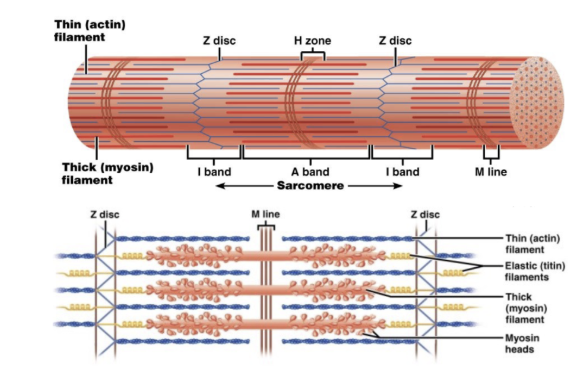
What is the H zone?
Lighter central region of the A band; contains only thick filaments.
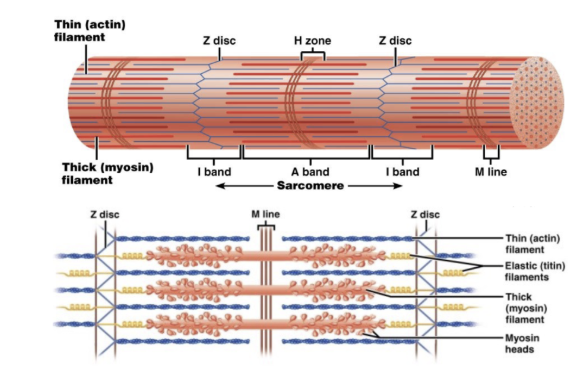
What is the M line?
Center of the H zone; rods hold thick filaments together.
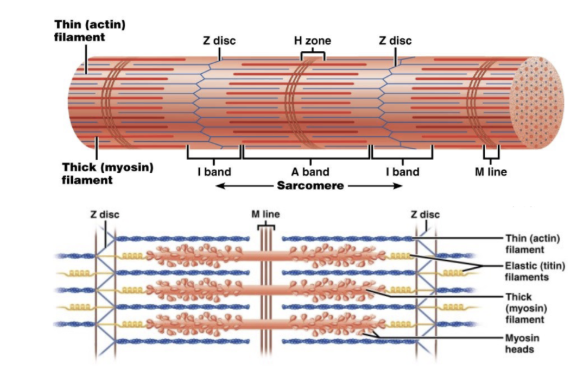
What is the I band?
Light band containing only thin filaments. Spans two sarcomeres with Z disc through center. I = isotropic (refracts light uniformly).
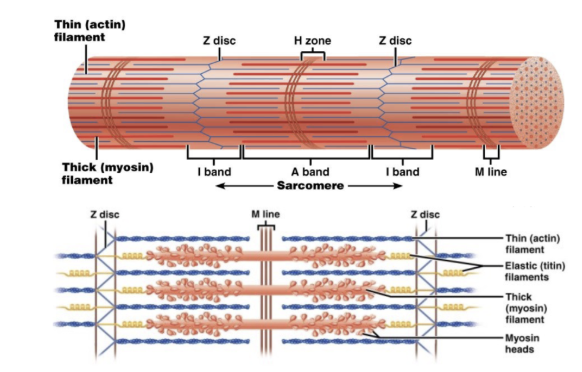
Why do skeletal muscle fibers appear striated?
Alternating dark A bands and light I bands, with striations of adjacent sarcomeres aligned across myofibrils.
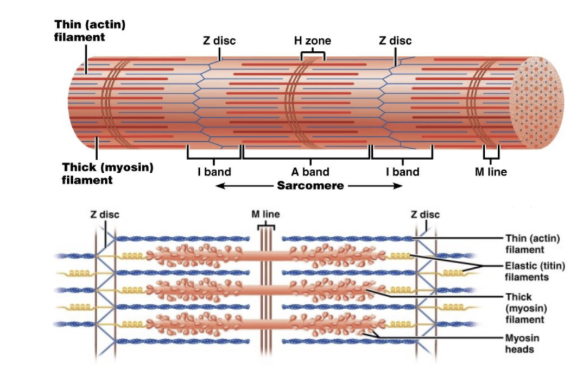
What is titin and its function?
Titin is a springlike protein running from the Z disc to the M line. It:
Anchors thick filaments (myosin)
Maintains sarcomere structure
Provides elasticity (stretches and recoils)
Prevents overstretching
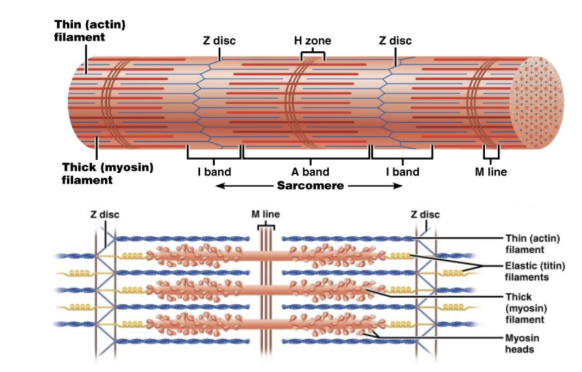
What is the role of other Z-disc proteins?
Mark the boundary of a sarcomere
Anchor thin filaments (actin)
Stabilize and link adjacent sarcomeres to maintain alignment during contraction and stretching
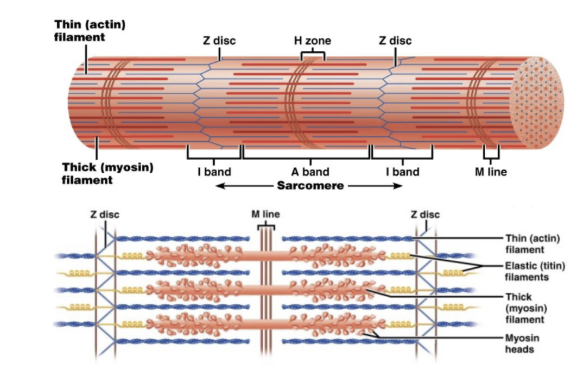
What is the Sarcoplasmic Reticulum (SR) and its structure?
Specialized smooth ER in muscle fibers.
Interconnecting tubules wrap each myofibril like a sleeve.
Terminal cisterns = enlarged perpendicular cross-channels.
Found in pairs at A–I junctions (one on each side of a T-tubule).
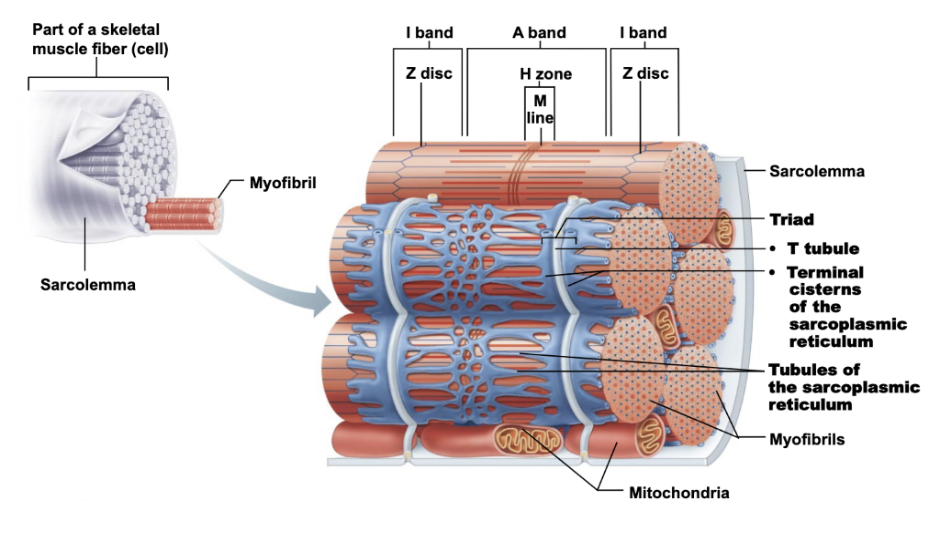
What is the function of the Sarcoplasmic Reticulum (SR)?
Stores Ca²⁺ → releases it when muscle is stimulated
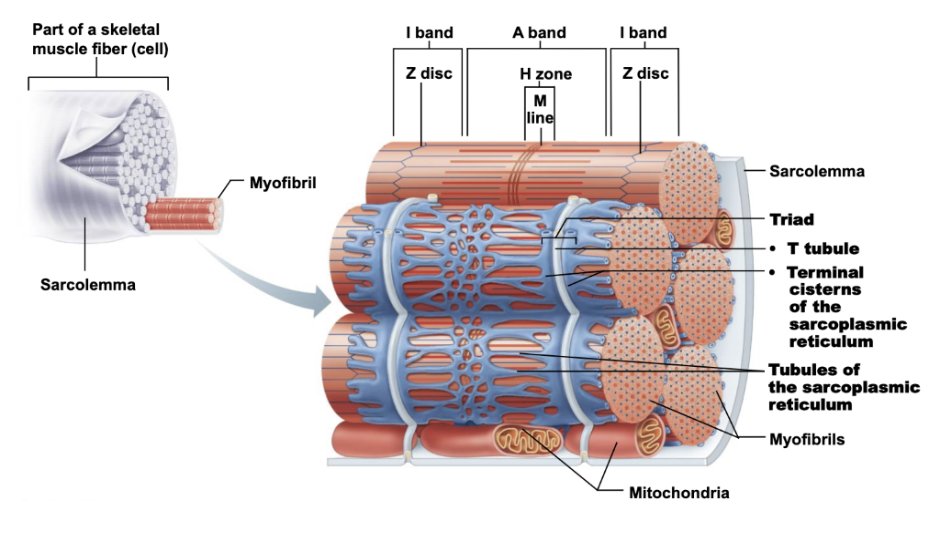
What are T-Tubules (Transverse Tubules) and their function?
They are deep folds of the muscle cell membrane (sarcolemma) that go into the muscle fiber.
Function: Carry nerve signals from the surface of the muscle deep inside the fiber.
This makes sure that all parts of the muscle fiber contract at the same time, not just the surface.
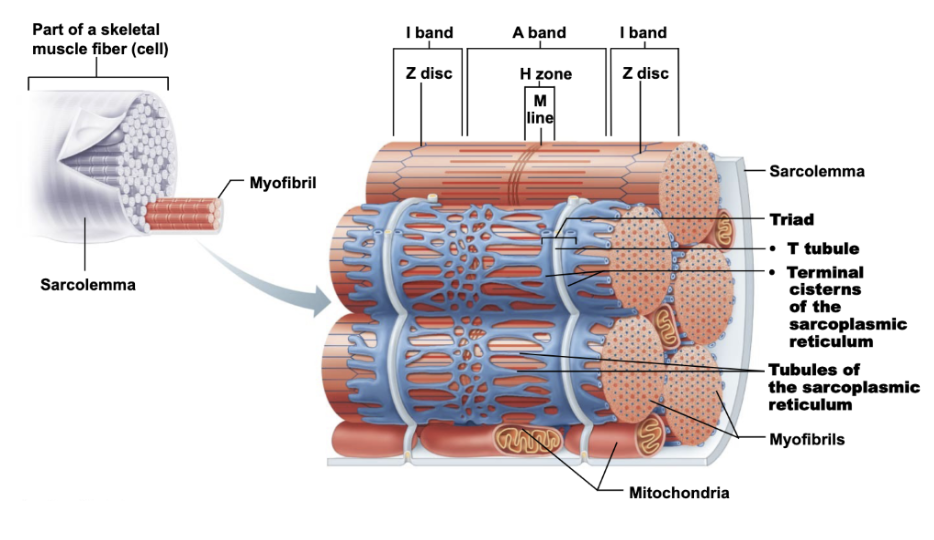
What is a Triad in skeletal muscle?
Structure: 1 T-tubule + 2 terminal cisterns
Located at A–I junction
Coordinates Ca²⁺ release for contraction
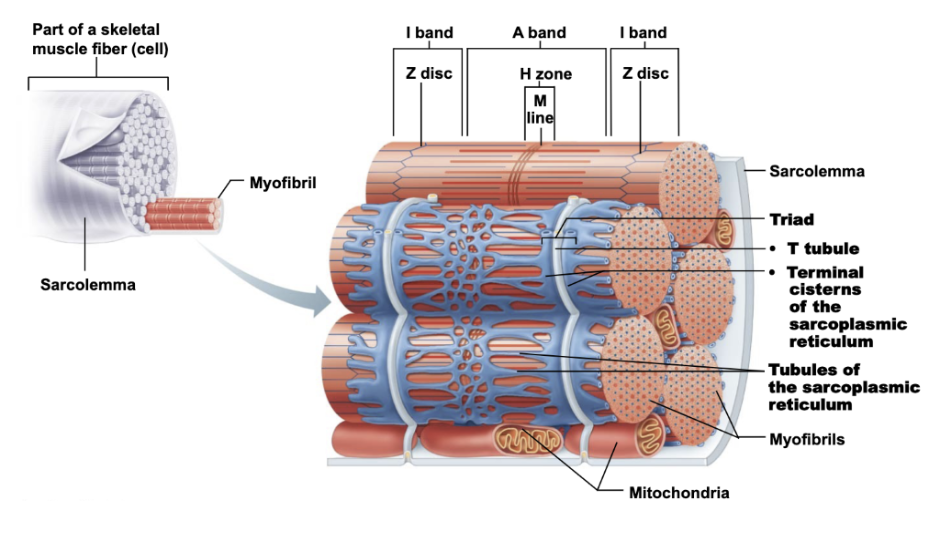
Summarize the mechanism of Ca²⁺-triggered muscle contraction?
Nerve impulse travels along sarcolemma
Impulse enters T-tubules → reaches deep myofibrils
Terminal cisterns release Ca²⁺
Ca²⁺ binds thin filaments → actin–myosin interaction begins
After contraction → Ca²⁺ is pumped back into SR for storage
What is a concentric muscle contraction?
Muscle shortens while generating force and is explained by the sliding filament mechanism.
Example: lifting a book or the upward phase of a push-up.
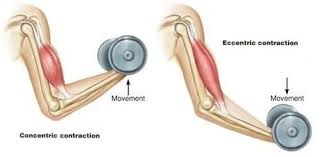
What is an eccentric muscle contraction?
Muscle lengthens while generating force. Acts as a brake against gravity. Example: lowering during a push-up.
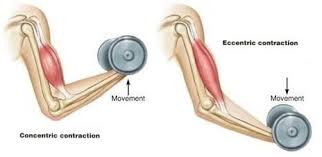
What happens in the sliding filament mechanism?
Thin filaments (actin) slide over thick filaments (myosin); sarcomere shortens but filaments do not.
Steps of the sliding filament mechanism
1. SR releases Ca²⁺ →
2. Ca²⁺ binds troponin → tropomyosin shifts → exposes actin binding sites →
3. Myosin heads bind actin → ATP powers “ratcheting” →
4. Filaments slide → sarcomere shortens.
How do sarcomere striations change during contraction?
Z discs move closer → I band shortens → H zone disappears → A band stays the same. Filaments slide, they don’t shorten.
How does muscle fiber length affect force generation?
Optimal length: Slightly stretched → max force; moderate overlap lets myosin pull along full thin filament.
Too stretched: Little/no overlap → weak force.
Too compressed: Thick filaments touch Z discs → minimal shortening.
What are motor neurons and their structure?
Nerve cells that signal muscle fibers to contract.
Dendrites: receive input.
Axon: transmits impulses to muscle.
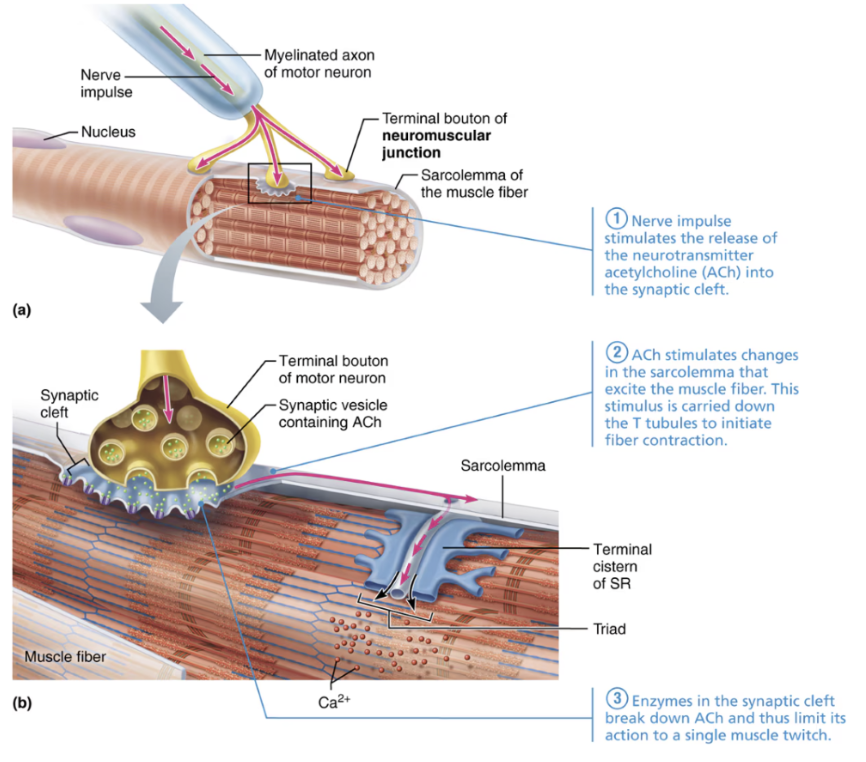
What is the neuromuscular junction (motor end plate)?
Point where a nerve ending meets a muscle fiber.
Terminal boutons: enlarged axon ends storing ACh.
Synaptic cleft: space between bouton & sarcolemma.
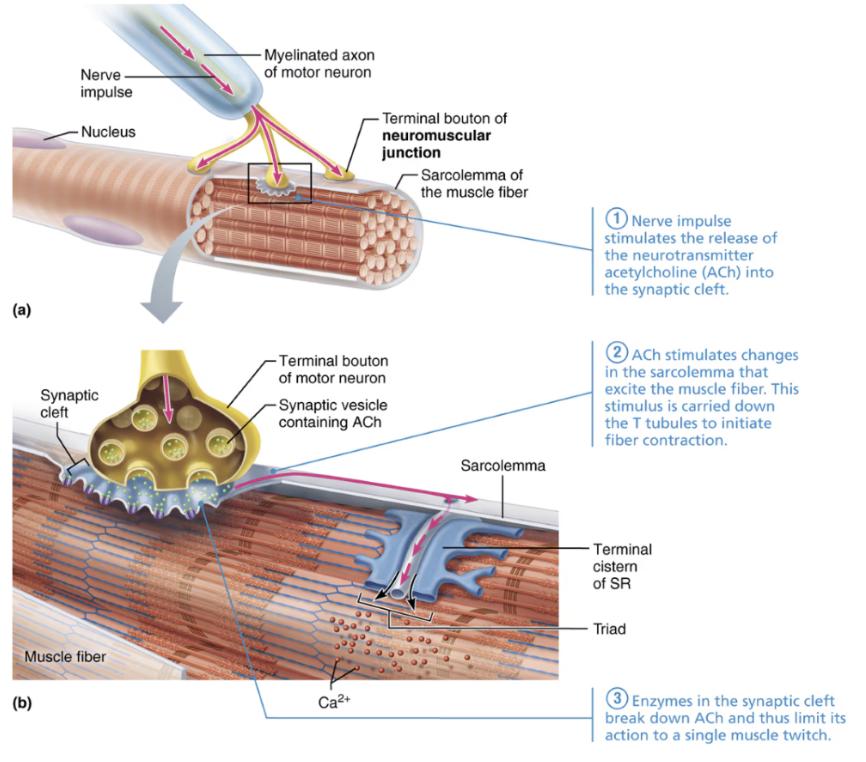
What happens when a motor neuron stimulates a muscle fiber?
Nerve impulse reaches terminal bouton.
ACh released into synaptic cleft.
ACh binds receptors on sarcolemma → triggers action potential.
Action potential → Ca²⁺ released from SR → contraction.
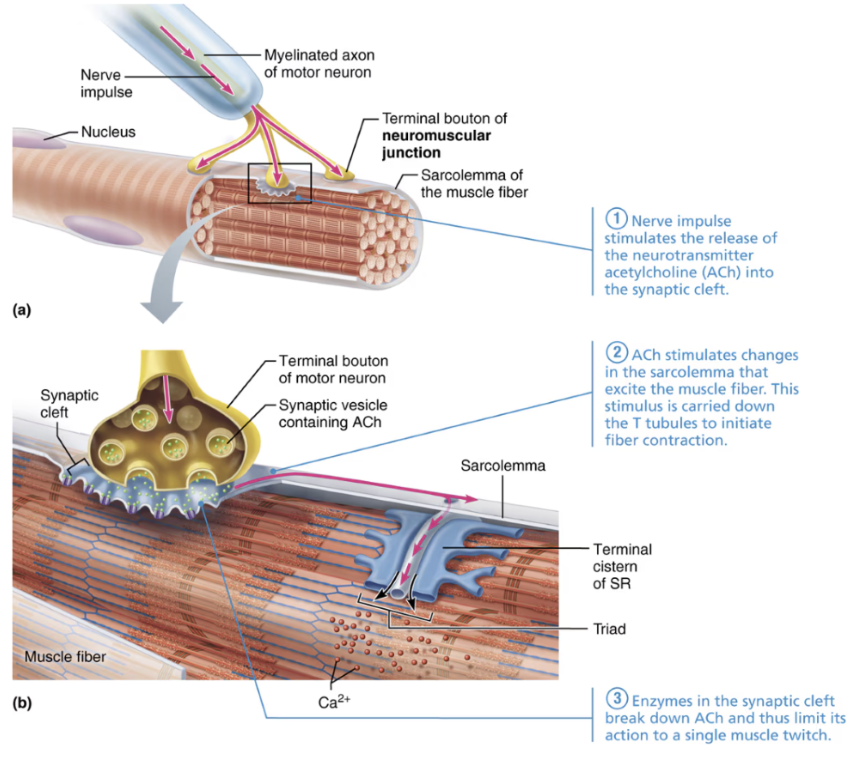
What is a motor unit?
A motor neuron + all the muscle fibers it innervates.
When the neuron fires → all its fibers contract together.
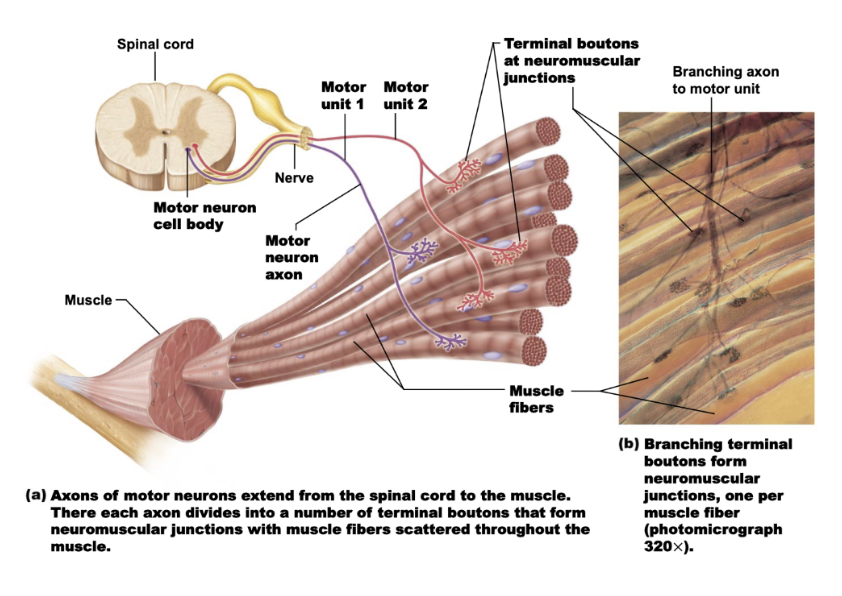
What are characteristics of motor units?
Average size: ~150 fibers/unit.
Range: 4 → several hundred fibers.
Fibers spread throughout muscle (not clustered).
Single unit → weak contraction; multiple units → strong contraction.
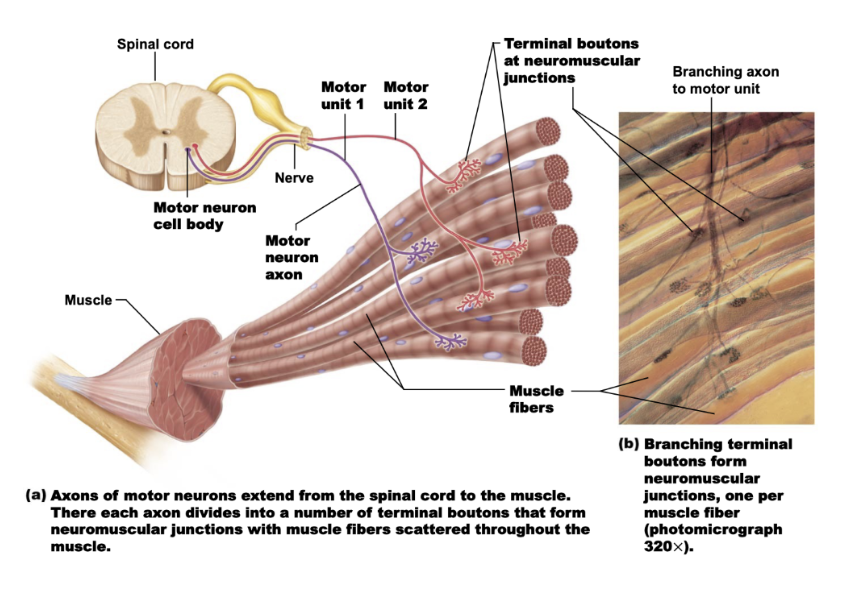
How do motor units differ functionally?
Fine control muscles (fingers, eyes): few fibers/unit → precise movement.
Large strength muscles (hip, calf): many fibers/unit → powerful but less precise.
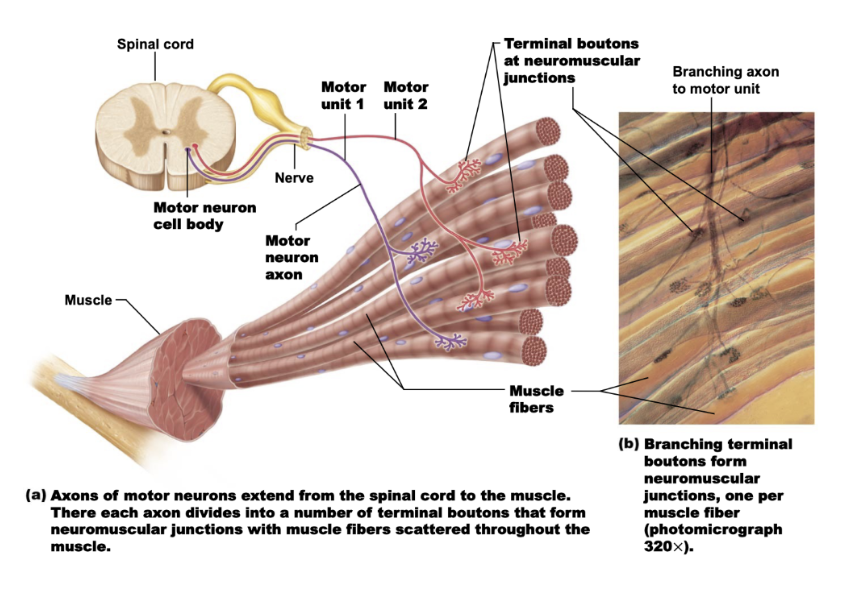
How are skeletal muscle fibers classified?
Energy production: oxidative (aerobic) or glycolytic (anaerobic).
By speed of contraction: slow or fast.
What are the three main types of skeletal muscle fibers?
Slow Oxidative (SO)
Fast Oxidative (FO)
Fast Glycolytic (FG)
What are the key traits of Slow Oxidative (SO) fibers?
Red (abundant myoglobin)
Many mitochondria & rich capillaries
Thin fibers → low power
Very fatigue-resistant
What are the key traits of Fast Glycolytic (FG) fibers?
Pale (little myoglobin), few mitochondria
Thick fibers → high power
Depend on anaerobic metabolism
Fatigue quickly
What are the key traits of Fast Oxidative (FO) fibers?
Intermediate/thicker fibers → moderate power
High myoglobin, many mitochondria, rich capillaries → somewhat fatigue-resistant
Contract faster than SO but slower than FG
Energy mainly aerobic
What is the general resistance of different muscle types to disorders?
Skeletal muscle: very resistant to infection; few disorders if properly nourished and exercised.
Smooth muscle: problems usually from external irritants.
Cardiac muscle: more prone to disorders than skeletal muscle.
What is Muscular Dystrophy (MD)?
A group of inherited, muscle-destroying diseases where affected muscles enlarge with fat and connective tissue, and muscle fibers degenerate.
What is Duchenne Muscular Dystrophy (DMD)?
Most common and serious type of MD.
Muscle fibers lack dystrophin → calcium leaks in → fiber damage → disrupted function.
Usually appears in childhood.
What is Myotonic Dystrophy?
Slow-progressing form of MD.
Can appear from birth to age 60.
Symptoms: muscle spasms, weakness, abnormal heart rhythm.
From what embryonic cells does all muscle tissue develop?
From mesoderm cells called myoblasts, which fuse to form skeletal muscle fibers.
Why are skeletal muscle fibers multinucleated?
Because myoblasts fuse during development, combining nuclei into one fiber.
When does skeletal muscle contraction begin in embryonic development?
By week 7 of embryonic development.
How do skeletal muscle fibers grow during childhood and adolescence?
Fibers lengthen and thicken as thick and thin myofilaments are synthesized; fibers do not undergo mitosis after formation.
What are satellite cells?
Immature cells around skeletal muscle fibers resembling myoblasts that:
Fuse with fibers for growth in youth
Aid regeneration after injury
Some remain for future repair
What are the limitations of skeletal muscle regeneration?
Severe damage often forms scar tissue, as skeletal muscle has limited regenerative capacity.
Can cardiac muscle regenerate?
No, cardiac muscle is highly specialized and does not regenerate significantly.
How do sex differences affect skeletal muscle?
Females: ~36% body mass is muscle
Males: ~42% body mass is muscle
Cause: androgens (testosterone) increase muscle growth
Strength per muscle unit is similar; total strength differs due to muscle mas
What is sarcopenia?
Age-related loss of muscle mass and strength.
What are effects of aging on muscle?
Increased connective tissue
Decreased number of fibers
Loss of muscular strength (up to ~50% by age 80)
Higher risk of falls and injury
How can aging-related muscle loss be mitigated?
Exercise and weight training slow fiber loss and maintain muscle size and strength.